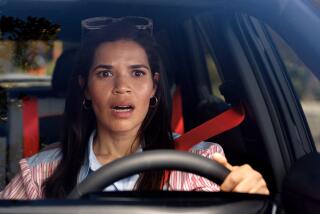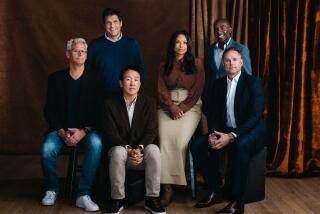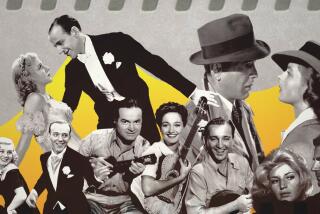TV on the Edge -- or Over It
- Share via
SAN FRANCISCO — The camera rolls as hosts Keith “Koolayd” Carthen and Jerome “Hustleman” Porter mug menacingly from a makeshift bar framed by cheap velvet curtains. The two drink cognac from paper cups and talk trash as they introduce videos of naked women gyrating to rap and hip-hop.
After proclaiming 2003 “the year of the thong,” Carthen adjusts his Oakland Raiders cap and announces that a viewer has complained that his public access TV show, “Reel Whirl II,” is sexist.
He shoots the camera a gangster glare. On cue, a fifth of Courvoisier slides down the bar into his grasp. “I plead the Fifth!” he cackles.
Carthen turns to his partner: “Do you ever get tired of [naked women]?”
“Nah.”
“Me, neither,” he says as another video rolls.
Public access television, envisioned as a folksy electronic forum for community announcements, school lunch menus and loftier notions of citizen democracy, has emerged as television’s most outlandish realm.
Stations nationwide offer the unedited whimsy of eccentric novice producers who will probably never be ready for prime time. Among the offerings have been the man in Michigan who went on the air with a penis puppet, the Manhattan show with close-up footage of underwater childbirth and the Los Angeles program on which porn stars display their skills.
But few stations can match San Francisco’s Channel 29 for on-camera surrealism. The city’s lone public access station is home to “Tranny Talk,” an Oprah-style gabfest for transgender people; the “Mr. Stinky Show,” featuring shock comedy skits; “You’ll Put Your Eye Out,” with how-to primers on making moonshine, shooting potatoes from a gun and other stunts; and “Bikers For Christ,” which features a bearded man in Hells Angel garb reciting biblical passages from a law library.
After 11 p.m. the lineup gets downright kinky. “Queen Bee TV” features a slinky woman in a bumblebee get-up who talks about her dolls, her mother’s shoes and other fetishes. On an obscenity-laced dominatrix show with a name too perverse to print, two women once covered themselves in chocolate and shaved people’s private parts while fielding phone calls from viewers.
On the “Bug Girl Show,” a woman shouts into the camera as she paces city streets, holding forth on such issues as male violence. On “Brainiac,” a man in a wedding dress and skeleton mask shows clips of Japanese cartoons.
Public access stations have been around since the 1960s, but not until 1984 did Congress establish a legal framework for such programming.
Under the Cable Communications Policy Act, local governments can require cable companies to set aside at least one station as a forum for members of the public to produce and air their own shows.
The idea was for cable providers to give something back in return for the billions of dollars they made wiring the nation’s living rooms for Home Box Office, ESPN, the Home Shopping Network and other for-profit programming.
Congress envisioned a meeting place where ordinary citizens could exchange ideas without commercial constraints or interference by network censors and taste-makers. Anyone with an idea could walk into the local public access studio, receive training and take to the airwaves. Cable companies would foot the bill.
Public access has evolved into a kind of open-mike format, in which people can, and sometimes do, say anything. The results sometimes entertain, often baffle and increasingly agitate viewers.
Channel 29’s crew of 200 amateur producers spans the spectrum from street-corner evangelists to political activists. There are underemployed comedians, rock star wannabes and self-styled performance artists.
Though some aspire to a political or artistic message, Carthen, creator of “Reel Whirl II,” says he has no agenda beyond sharing his enthusiasm for naked female bodies. He hopes to take his show to a wider audience on HBO or the Playboy Channel someday.
“People dig my show, and it’s not just the hip-hoppers,” he says. “I wouldn’t be surprised if all the preachers and church choirs in town were tuning in.”
Station Watchdogs
A professor, an independent producer and a disability rights activist sit in Channel 29’s Market Street studios. Members of the station’s program committee, they stare grimly at a TV monitor, reviewing two programs that have inspired viewer complaints.
A seven-minute segment from “D World” -- the D is short for Dope -- shows a blindfolded woman performing lewd acts using a bottle of Miller Genuine Draft.
Peggy Coster, the disability advocate, winces at the footage: “I’m worried about this woman’s safety.”
“Maybe we should add a disclaimer,” says another committee member. “ ‘Don’t try this at home.’ ”
Coster and her colleagues are watchdogs guarding an ill-defined boundary. While trying to preserve public access TV’s mandate as an unfettered electronic soapbox, they also try to gauge when shows such as “D World” or “Reel Whirl II” cross the line into obscenity.
Fewer than 15% of the 200 regularly scheduled shows on Channel 29 are sexually explicit. Yet across the country, such programs are emerging as a battleground that could shape the future of public access TV.
The 1984 cable act confers free-speech rights on public access shows. Unlike commercial stations, which can censor language, tone down political commentary or cancel programs on an executive’s whim, public access supervisors do not pre-screen or cut shows. If a public access station refuses to run a show, the producer can sue.
Yet program managers are also bound by Federal Communications Commission guidelines that forbid airing obscene shows. And they worry about being prosecuted by local district attorneys for violating anti-obscenity laws.
“Free speech sounds great on paper,” said John W. Higgins, an associate professor of mass communications at Menlo College in the Bay Area and chairman of Channel 29’s program committee. “But on the front lines it’s very messy.”
Creating the Rules
So public access stations create their own guidelines or rely on community standards, as defined in court decisions.
The result: Programs that are acceptable in San Francisco could be deemed taboo in more conservative locales such as Sacramento, where public access manager Bob Wilson complains: “I can’t run anything left of Hitler. The community won’t stand for it.”
In Berkeley, regarded as a bastion of free expression, officials want to move adult shows to time slots after midnight.
In Tampa, Fla., county commissioners offended by adult programming tried to shut down the local public access channel. A federal judge ordered continued funding of the station just hours before it was to go dark.
Even Los Angeles, the cradle of the nation’s adult film industry, has acted to curb sexually explicit programming.
In 1999, City Council members changed the format of Channel 36, the only citywide public access station, to arts and educational programming. They were responding to complaints about such shows as “Colin’s Sleazy Friends,” a showcase for porn stars, and a syndicated sex talk show featuring a therapist in skimpy lingerie who dispenses advice while lying in bed. (The shows are still available on other access channels.)
Now, the city is studying whether to relocate public access TV to the Internet, where “it’s not in people’s faces,” said Liza Lowery, head of the city’s Information Technology Agency.
Public access television has fought other free-speech battles.
Bitterford, Maine, temporarily shut down its station after a local businessman said he was slandered during a call-in show. In Palestine, Texas, officials tried to close the local station after a show criticized local government. Officials in Kansas City, Mo., tried to cut public access funding rather than run a program sponsored by American Nazis.
Zane Blaney, executive director of San Francisco’s Channel 29, worries that such controversies will diminish support for what he calls TV’s final creative frontier.
“The perception is public access is the porno channel, and it’s so much more than that,” he said. “But if the opinions influence community support, we could lose public access. And that would be a dark day.”
Equipment and Training
Each month, 50 aspiring producers gather at Channel 29 for an orientation on how to use the station’s three state-of-the-art cameras and sound room. Many don’t return after learning how much work goes into producing a regular program delivered to the city’s 200,000 cable subscribers.
Those who do are solely responsible for their shows -- many of which are taped at home or on location -- and must notify the station of any adult content so the program can be aired after 11 p.m.
Blaney says his policy is to never watch any show before it runs.
“If I pre-screen and cancel a show, the producer could sue for breach of free speech rights,” he said. “But if I watch and approve a show with problems, I could face charges.”
When an offensive program airs, he says, he’s as shocked as anyone.
Once, he accidentally ran in the 8 p.m. family time slot a show that combined graphic sexual footage with outtakes from “Saturday Night Live” lampooning gay culture. “There were sex acts I didn’t even know there were names for,” Blaney said. “I spent weeks fielding calls on that one.”
Once, a district attorney’s investigator went to the station, demanding a copy of a program that a viewer had complained was obscene. A flustered Blaney handed over the tape. Prosecutors later determined that no law had been broken.
One Saturday night, Blaney happened to catch a live segment of the dominatrix show. Two women shouted obscenities at callers and shaved a man’s buttocks and testicles on screen.
“First, I was amazed. Then I was chagrined,” he said. “But it ended up being the most compelling TV I’ve seen in a long time. The calls were coming in one after the other, but people weren’t complaining. Instead, it was: ‘You go, girls.’ ”
But station officials insist that such fare be shown only late at night. Beth Mann, creator of “Thrush TV,” ran afoul of station rules with a prime-time segment that showed a male job applicant who was required to disrobe during an interview.
The committee moved “Thrush TV” to a time slot after 11 p.m. Mann is not pleased.
“My show features soft-core nudity, but we take on legitimate issues,” she says. “I’ve been banished to the late hours, where instead of serious viewers I get e-mails from guys saying, ‘Show me your breasts.’ ”
A Mother Gasps
Katherine Lewis, a San Francisco mother of three, was channel surfing after 11 p.m. one night -- ready for a few laughs watching “Saturday Night Live” with her teenage daughters. Then she saw something that made her gasp: an episode of “Reel Whirl II.”
At first she thought she was viewing a pay-TV promo. Then she realized the offending images were on the public access channel. “What bothered me is that it was so very sexist,” she said. “All the men were clothed. But all the women were in various states of undress, being used as toys.”
When Lewis contacted Channel 29, Blaney explained her options: She could change the channel or have her cable company block the station. She could contact the FCC or local prosecutors. Or she could come to the studio and produce her own show in response.
Lewis says there is no place for “pornography” on television, at any hour. “Especially public access TV,” she said. “You expect more from them.”
Carthen of “Reel Whirl II” has this to say to his critics: “If you let your children watch my show, you’re not good parents. Don’t exercise control on me. Exercise some control on yourself and your own kids.”
He starts each episode with a disclaimer: “Parental Advisory. Put the kids to bed.”
More to Read
The complete guide to home viewing
Get Screen Gab for everything about the TV shows and streaming movies everyone’s talking about.
You may occasionally receive promotional content from the Los Angeles Times.







